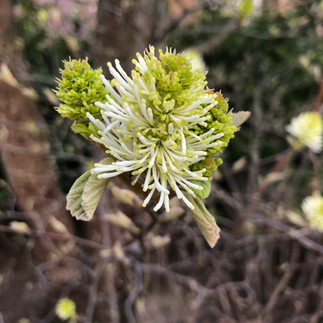Chesapeake Celebrities: Favorite Fall Natives
- Nuts for Natives
- Feb 9, 2022
- 3 min read
Spring is the time to plant shrubs for fall foliage, berries and more!
Now, when the winter is long, is an ideal time to check how your garden is faring as a bird feeder. Are berries available? Seed heads standing? If you want to add more for next winter, spring is a great time to add shrubs.
I checked in with a few Chesapeake celebrities to ask about their favorite fall shrubs. These aren't your red carpet celebrities; these are green carpet celebrities, the best kind! They work every day helping us make better choices.
Ginger Woolridge
Ginger, a trained landscape architect and garden consultant, is co-author of "Essential Native Trees and Shrubs for the Eastern United States." If you don't know the book, it is a treasure trove of information, beautiful, and realistic, photographs and concise information about native shrubs and trees. My copy is dog eared. It is recommended by Dr. Doug Tallamy and the New York Times.
Ginger's favorite fall shrub? Fothergilla. Ginger says "both sizes!" Dwarf fothergilla (Fothergilla gardenii) grows about 4 feet high and wide. Large fothergilla (Fothergilla major) grows 6 to 10 feet high. Both grow in sun to part shade and in most any soil. The white flowers in spring burst open mid-spring. Fall brings a fantastic palette of fiery oranges and reds.
Mike Burke

Mike, a public servant who has worked tirelessly for the restoration of the Chesapeake Bay, is an avid birder and writes "On the Wing," a delightful and informative column in The Bay Journal, the publication about all things Chesapeake!
Mike's favorite shrub for fall? Beautyberry (Callicarpa Americana). Mike says he grew beautyberries at his home in Cheverly, and they were always a delight. Mike still enjoys beautyberries in Mitchellville, where he and his wife Pat now live.
Beautyberry jumps into one's gardening consciousness in early fall. Purple berries seem to appear out of nowhere. This shrub grows well in full sun and part shade in moist soils though you can grow it in average and clay soils as well. A mature shrub reaches up to 6 feet high and wide.
Jenny Houghton

Jenny, Assistant Director at Maryland's Adkins Arboretum, a magical place for native plants, writes "Nature Notes" in a weekly newsletter about native flora and fauna. Check out her current post on fireflies ... and what they are doing in winter!
A keen observer of nature, Jenny says her two favorite native shrubs for fall are native euonymus, sometimes called hearts-a-bursting, wahoo or American strawberry bush (Euonymus americanus) and northern highbush blueberry (Vaccinium corymbosum). Jenny says she was first introduced to euonymus at the Arboretum. "Fifteen years later, I still get excited when the berries appear in early fall. Vaccinium reminds me of many happy hiking trips in the mountains of West Virginia."
Native euonymus grows in moist areas, part or dappled shade. It is reported to grow to 6 feet high though very mature shrubs get taller. Its' claim to fame are those capsules and fruit in fall!
Highbush blueberry also grows to 6 feet high and needs full sun and acidic soils to really thrive. In addition to white flowers and blue berries, deep crimson fall colors make it a fall fave.
Jeremy Tidd
Jeremy, founder of Bona Terra Nursery in Anne Arundel County, is growing native plants on a large scale. Read more about Bona Terra here. If you use Instagram, Jeremy's feed is amazing. It is a veritable font of information about where popular native plants grow, such as little bluestem, to incredible detail about little known insects sustained by native plants. Jeremy knows a tremendous amount about native plants!
Jeremy's favorite fall shrubs? Shrubby St. John's wort (Hypericum prolificum) and fragrant sumac (Rhus aromatica). Jeremy says he chose these because of their appeal to human needs, ability to thrive in urban spaces, the fact they are often overlooked, and their kaleidoscopic colors in the fall! Jeremy also notes the bark of older St. John's wort plants exfoliates, giving it winter interest as well.
While I don't have any experience with these, if Jeremy recommends it, we are good. Shrubby St. John's wort grows in full sun to part shade, flowers through summer, can form a lowish hedge or border, bees love it. That would seem to cover it. This is one of those plants where you do need to be mindful while shopping. There are a number of non-native St. John's worts native to Europe and southern Asia sold, particularly at larger garden centers. This is where those latin names come in handy: "prolificum" is the native; "calycinum" and "perforatum" are non-native. Your best bet is a native plant nursery.
Fragrant sumac grows about 8 feet high and wide in full sun and filtered shade. It grows well in average moisture conditions and drier conditions. The photos from Mt. Cuba say it all.
Most wonderful choices all! Thank you for being the best kind of celebrities too.


























































Comments